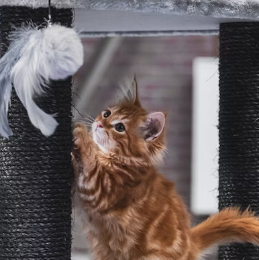
5 Tips to Keep Your Cat from Scratching Your Furniture
Share
Cats are known for their natural instinct to scratch, and while it's a normal behavior for them, it can be frustrating for cat owners when furniture becomes their preferred scratching post. However, with a few preventive measures and redirection strategies, you can help save your furniture from your cat's sharp claws. In this blog, we'll share five effective tips to keep your cat from scratching your furniture.
Provide Appropriate Scratching Alternatives
Cats need an outlet for their scratching behavior, so it's important to provide them with suitable alternatives. Invest in a sturdy and tall scratching post or cat tree that offers different textures and surfaces. Cats have individual preferences, so experiment with different materials like sisal, carpet, or corrugated cardboard to see which one your cat prefers. Place the scratching post in a prominent and accessible location, near the furniture they tend to scratch, to encourage their use.

Make Furniture Less Attractive to Scratch
Cats are more likely to scratch furniture that has appealing textures or scents. To deter them, you can use double-sided tape, aluminum foil, or plastic sheeting to cover the areas they target. These textures are unpleasant for cats and discourage scratching. Additionally, you can apply a pet-safe deterrent spray on the furniture to make it less enticing. Regularly reinforce the idea that furniture is not a suitable scratching surface by redirecting your cat to their scratching post whenever you catch them in the act.
Trim Your Cat's Nails
Regular nail trims can help minimize the damage caused by scratching. Trim your cat's nails every few weeks using cat-specific nail clippers or seek assistance from a professional groomer or veterinarian. Be cautious not to trim too close to the quick, as it can cause pain and bleeding. By keeping your cat's nails short, you reduce the impact of their scratching on your furniture.

Positive Reinforcement and Rewards
Encourage your cat to use their designated scratching post by using positive reinforcement techniques. Whenever you see your cat scratching the appropriate surface, offer verbal praise, gentle petting, or a small treat as a reward. Positive reinforcement helps create a positive association between the scratching post and a pleasurable experience. Consistently rewarding and acknowledging their preferred behavior will motivate your cat to continue using the scratching post instead of the furniture.

Protect Furniture with Barriers or Covers
If your cat persistently targets specific furniture pieces, consider using protective barriers or covers. Use plastic or fabric covers designed specifically for furniture protection, or repurpose thick blankets or throws to create a physical barrier. This temporary measure can help safeguard your furniture while you work on redirecting your cat's scratching behavior to more appropriate surfaces.
Bonus Tip
Trim catnip-infused scratching pads can be enticing for some cats. Place them near the furniture you want to protect to redirect their attention and encourage the use of the scratching pad instead.
Remember, patience and consistency are key when training your cat to redirect their scratching behavior. Avoid punishment or negative reinforcement, as it can create fear and anxiety in your cat, making the situation worse. Instead, focus on providing attractive alternatives and rewarding desired behaviors.

In addition to these tips, ensure that your cat has plenty of mental and physical stimulation. Engage in regular play sessions using interactive toys to burn off excess energy and provide an outlet for natural hunting instincts. A well-exercised and mentally stimulated cat is less likely to resort to destructive scratching behaviors.
By implementing these preventative measures and redirection strategies, you can effectively discourage your cat from scratching your furniture and preserve your cherished pieces. With patience, consistency, and a little bit of creativity, you and your feline friend can coexist harmoniously in your home.
